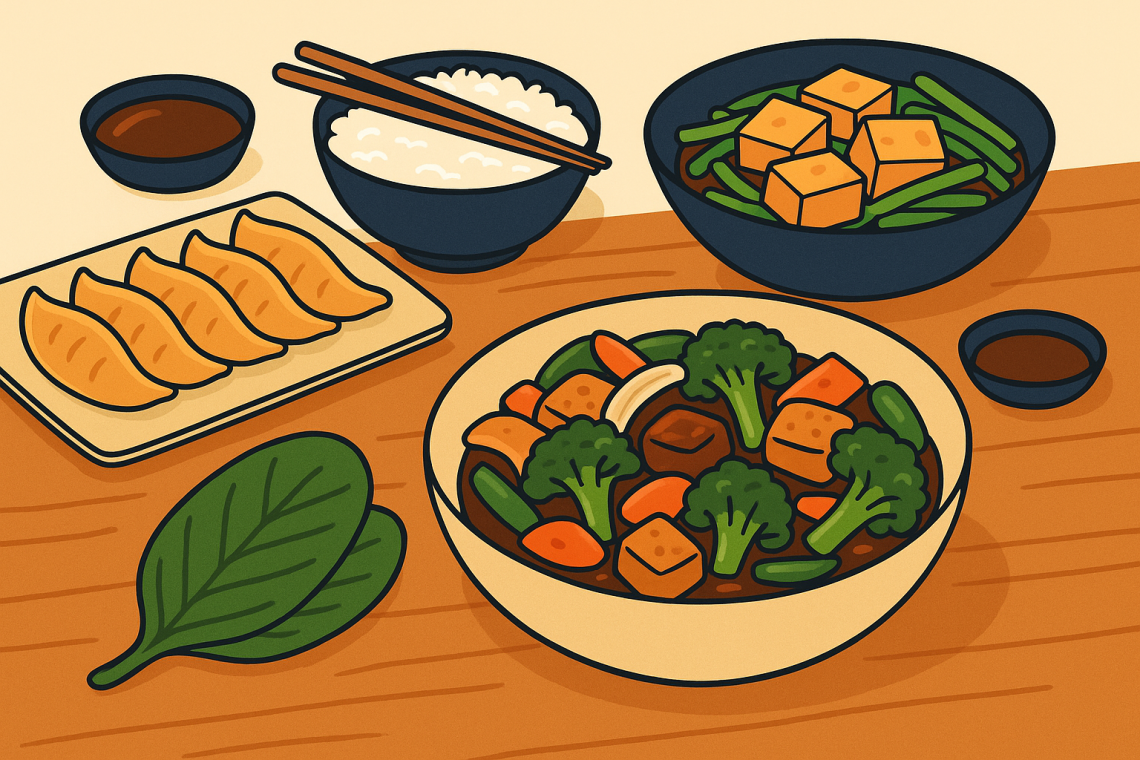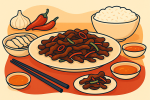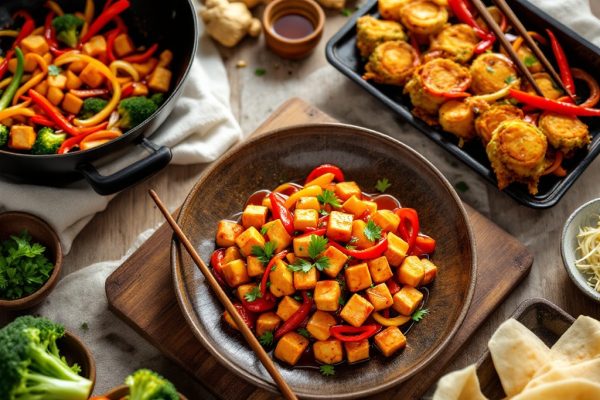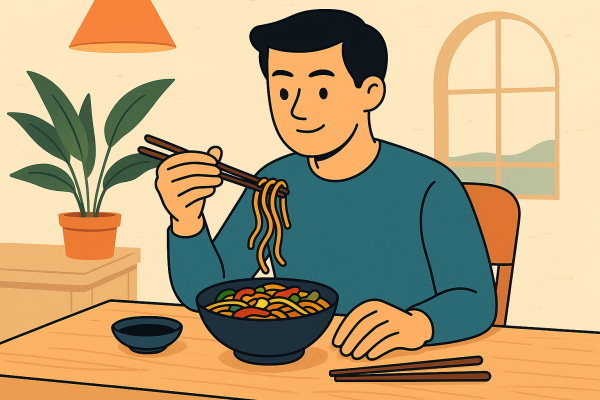Plant-Based Feasts: Delicious and Authentic Vegan Chinese Recipes
Discover the vibrant world of vegan Chinese cuisine! Explore flavorful dishes packed with fresh vegetables, tofu, and plant-based proteins like wheat gluten. From savory Mapo Tofu and Kung Pao Cauliflower to comforting Millet Congee and festive Vegan Mooncakes, this culinary journey offers a delicious and healthy experience. Learn how to enhance flavors with traditional seasonings, create umami with ginger-garlic sauce, and master oil-free cooking methods. Dive in and savor the richness of Chinese vegan cooking!
Important information
- Chinese cuisine offers diverse vegan options, from traditional dishes like Mapo Tofu and Dan Dan Noodles to adapted classics. Tofu, wheat gluten, mushrooms, and fresh vegetables form the base of many dishes.
- Flavor is key, using aromatics like ginger, garlic, and scallions, along with soy sauce and other spices to create complex and savory dishes. Umami is often achieved with ginger-garlic sauce and soy sauce combinations.
- Oil-free cooking methods, such as steaming and stir-frying with water or broth, are common, promoting healthy eating and preserving nutrients.
- Whole-food, vegan Chinese recipes emphasize minimally processed ingredients and fiber-rich grains for added health benefits, including protection against heart disease, type 2 diabetes, and certain cancers.
- Tofu’s versatility shines in vegan Chinese cooking, as it absorbs flavors well and adapts to various cooking methods, from stir-fries to soups. Wheat gluten (kao fu) is another valuable plant-based protein source, often braised for a chewy, meat-like texture.
The Richness of Chinese Cuisine in Vegan Dishes
Chinese cuisine offers a wide array of vegan options. Traditional dishes often highlight fresh vegetables, mushrooms, tofu, and plant-based proteins like wheat gluten. Aromatics such as ginger, garlic, and scallions, along with spices and sauces like soy sauce, create complex layers of flavor. These ingredients are key to popular vegan dishes like Dan Dan Noodles, Kung Pao Cauliflower, and Mapo Tofu. Many traditional dishes are already vegan, while others can easily be adapted, showcasing the cuisine’s versatility in plant-based cooking. For example, Sweet and Sour Vegetable Soup gets a rich umami flavor from shiitake mushrooms. Oil-Free Farro Fried Rice provides a healthy twist on a classic dish. From stir-fries and noodles to dumplings and soups, the variety of Chinese vegan cuisine offers a delightful culinary experience.
Traditional Vegan Chinese Recipes
Experience the vibrant and healthy world of vegan Chinese cuisine. This culinary tradition showcases plant-based proteins like tofu and wheat gluten, alongside a rich variety of vegetables such as bok choy, eggplant, and mushrooms. Staples like noodles, rice, and grains complete the foundation of these flavorful dishes. Indulge in vegetable dumplings, sticky rice mushroom shumai, or braised wheat gluten with mushrooms. These dishes capture the essence of veganism while honoring traditional Chinese flavors, offering a delightful way to enjoy familiar tastes with a plant-based twist. They demonstrate the culinary versatility of plant-derived ingredients.
Role of Tofu in Chinese Cuisine
Tofu, a cornerstone of Chinese cuisine, has delighted palates for centuries. Its versatility in vegan cooking comes from its ability to absorb flavors, making it ideal for stir-fries, soups, and stews. This protein-rich ingredient seamlessly substitutes into many traditional dishes. From stir-frying and grilling to steaming and braising, tofu preparation offers numerous possibilities, often enhanced by marinades, sauces, and a variety of vegetables. Truly, tofu is a culinary chameleon.
Variety of Vegetables and Mushrooms
Chinese cuisine embraces a variety of vegetables, such as bok choy, gai lan, and choy sum. Mushrooms, like wood ear, shiitake, and enoki, are also essential ingredients. This diverse array of components contributes complex flavors and unique textures to vegan dishes, making them both flavorful and enjoyable.
Healthy Eating with Whole-Food Vegan Chinese Recipes
A whole-food, vegan Chinese diet offers a wealth of health benefits, boosting your vegetable intake while providing diverse plant-based nutrients. This approach emphasizes minimally processed ingredients like tofu, bok choy, eggplant, shiitake mushrooms, and staples such as rice and noodles. Aromatic additions like ginger, garlic, and soy sauce infuse dishes with authentic Chinese flavors. Traditional vegan recipes, such as Sticky Rice Mushroom Shumai and Vegetable Dumplings, beautifully showcase this culinary style. Adapting classic dishes is also easy; simply omit animal products from your favorite stir-fries and noodle dishes. Oil-free cooking methods, including steaming and stir-frying, are crucial for preserving nutrients and maximizing flavor. Enhance the nutritional value further by incorporating fiber-rich grains, like in Oil-Free Farro Fried Rice. Expand your protein repertoire by exploring traditional vegan options like Hong Shao Kao Fu (Braised Wheat Gluten with Mushrooms).
Benefits of a Whole-Food Diet
Nourishing your body with whole foods, like fruits, vegetables, and whole grains, offers numerous health benefits. These nutrient-rich foods are packed with fiber, vitamins, and minerals, which significantly protect against heart disease, type 2 diabetes, and certain cancers. Additionally, a whole-foods diet promotes healthy digestion and boosts energy levels. A *Journal of the American Heart Association* study also linked whole-food diets to improved weight management. Choose whole foods for a healthier lifestyle.
Incorporating Fiber-Rich Grains
Boost your digestion and fuel your body with fiber-rich grains like brown rice, quinoa, and millet. These versatile grains offer various culinary possibilities:
- Stir-fries,
- Foundations for various meals,
- Warm, comforting bowls of congee.
Enjoy sustained energy and improved digestive health by incorporating these grains into your diet.
Oil-Free Cooking Techniques
Vegan Chinese cooking offers a variety of oil-free cooking methods, including steaming, baking, grilling, and stir-frying. Water or vegetable broth is often used instead of oil, which helps to maintain the fresh flavors of the vegetables, tofu, and other plant-based ingredients. This approach results in meals that are both healthy and delicious.
Flavor-Forward Vegan Chinese Recipes
Vegan Chinese food is an explosion of flavor, using exciting ingredients like tofu, mushrooms, and wheat gluten as meat replacements. Shiitake, oyster, and enoki mushrooms bring a savory depth, while aromatic spices like ginger, garlic, soy sauce, and chili bean paste create a rich umami base. Essential cooking techniques such as stir-frying and steaming enhance the natural flavors of vegetables like bok choy, eggplant, and gai lan. Dishes like Mapo Tofu, Kung Pao Cauliflower, and Sweet and Sour Vegetables are prime examples of how satisfying and flavorful vegan Chinese cuisine can be.
Enhancing Flavors with Seasonings
Seasonings are essential for delicious vegan Chinese cuisine, enhancing the natural flavors of vegetables. Aromatics like ginger and garlic create a fragrant base. Soy sauce contributes saltiness and richness is added by sesame oil. Spices further deepen the complexity of the dishes. This careful balance of seasonings transforms simple vegetables into flavorful, satisfying meals.
Creating Umami with Ginger-Garlic Sauce and Soy Sauce
In vegan Chinese cuisine, the savory, delicious “umami” flavor often comes from a dynamic duo: ginger-garlic sauce and soy sauce. This powerful combination adds depth to dishes like Sweet and Sour Vegetable Soup or Bok Choy in Ginger-Garlic Sauce. While soy sauce contributes saltiness, the ginger and garlic provide a pungent aroma, creating a complex and satisfying umami experience.
Plant-Based Proteins in Chinese Cuisine
Tofu, made from soybeans, is a cornerstone of vegan Chinese cuisine. Its ability to absorb flavors makes it incredibly versatile, starring in dishes like spicy Mapo Tofu, stir-fries, soups, and even desserts. It’s also a valuable source of plant-based protein.Similarly, braised wheat gluten, or kao fu, offers a satisfying, chewy texture reminiscent of meat. This makes it ideal for vegetarian stews and stir-fries, where it readily soaks up the surrounding flavors. Braised in flavorful broths with spices and vegetables, kao fu adds a delicious depth to many dishes.
Tofu: A Staple in Vegan Chinese Recipes
Tofu, a versatile soy-based protein, is essential to vegan Chinese cuisine. Its ability to absorb flavors makes it ideal for stir-fries, soups, and braises. Furthermore, it provides a substantial protein source in traditionally meat-based dishes, like Mapo Tofu and Kung Pao Tofu, showcasing its adaptability.
Exploring Braised Wheat Gluten (Kao Fu)
Kao Fu, braised wheat gluten, is a popular cold appetizer in Chinese cuisine, offering a substantial plant-based protein source. It’s often served before the main courses, and its texture and taste are similar to tofu. For a flavorful twist, try Hong Shao Kao Fu, which incorporates braised mushrooms along with the wheat gluten.
Appetizing Vegan Chinese Starters
Start your meal with the refreshing tang of Chinese Pickled Cucumbers.
Vegan Sticky Rice Mushroom Shumai
Savor the classic flavors of China with these flavorful dumplings packed with umami.
Vegetable Dumplings
Enjoy a vibrant burst of color with these dumplings, a true rainbow on your plate.
Sticky Rice Mushroom Shumai
These vegan sticky rice and mushroom shumai are bursting with flavor, making them a delicious appetizer or brunch option. Glutinous rice and shiitake mushrooms form the base of the filling, complemented by other vegetables. This savory mixture is then delicately wrapped in dumpling skins and steamed to perfection. The resulting shumai offer a delightful combination of textures and tastes.
Vegetable Dumplings with a Rainbow of Veggies
These savory dumplings are packed with vibrant, fresh vegetables, like cabbage, carrots, scallions, and mushrooms. A hint of garlic and ginger enhances the delicious filling, which is then encased in delicate wrappers. Enjoy these versatile treats steamed, boiled, or pan-fried.
Chinese Pickled Cucumbers
Making Chinese pickled cucumbers is easy and requires no special equipment. Simply slice the cucumbers and marinate them in a mixture of vinegar, salt, and spices. The result is a crunchy, refreshing side dish perfect for those who enjoy a plant-based lifestyle.
Vegan Chinese Main Courses: Comforting and Wholesome
Savor the deliciousness of Chinese Stir-Fried Eggplant, a dish that melds tender eggplant with aromatic garlic, ginger, and savory soy sauce.
Symbolizing longevity, Long Life Noodles (Yi Mein) are a celebratory dish often enjoyed during birthdays.
Buddha’s Delight, a vibrant medley of vegetables and tofu, is a staple for Chinese New Year.
For a plant-based twist on a classic, try Vegetarian Roast Goose. Crafted from seitan or tofu skin, it captures the crispy skin and rich flavor of roast goose.
Turn up the heat with Sichuan Stir-Fried Potatoes, a fiery combination of potatoes, Sichuan peppercorns, and chili bean paste.
Finally, indulge in Vegan Mooncakes, sweet treats filled with red bean or lotus seed paste, traditionally enjoyed during the Mid-Autumn Festival.
Chinese Stir-Fried Eggplant
This vegan Chinese Stir-Fried Eggplant is a culinary delight featuring eggplant, a cornerstone of Chinese cuisine. The eggplant is stir-fried until tender, then coated in a savory sauce, often featuring garlic, ginger, and soy sauce. Some variations include a rich garlic sauce or the addition of bell peppers and green beans. It’s a delicious example of vegan Chinese cooking.
Vegetarian Roast Goose
Enjoy the savory, umami flavors of vegetarian roast goose, a plant-based version of a Chinese classic. This vegan dish offers a satisfying experience for anyone exploring meatless Chinese cuisine.
Long Life Noodles
In Chinese culture, Long Life Noodles (Yi Mein) symbolize a long, prosperous life, and good fortune. They are often served at birthdays and New Year celebrations. This traditional dish features a unique texture perfect for stir-fries, adding a festive touch to any special occasion.
Sichuan Stir-Fried Potatoes
Sichuan stir-fried potatoes are a flavorful vegan staple of Chinese cuisine. This simple dish highlights the potato’s versatility in Chinese cooking and stands as a true classic.
Buddha’s Delight for Chinese New Year
Buddha’s Delight, or Lo Han Jai, is a flavorful vegan dish enjoyed during Chinese New Year. It’s packed with ingredients like wood ear and shiitake mushrooms, pressed tofu, and bean thread noodles. Fresh vegetables such as bok choy, carrots, and snow peas add a crispness, while soy sauce and sesame oil create a savory depth.
Vegan Mooncakes
Celebrate the Mid-Autumn Festival with delicious vegan mooncakes, a modern twist on a classic treat. These plant-based delights offer the same rich symbolism as traditional mooncakes, but without any animal products. Fillings often include sweet red bean or lotus seed paste, encased in a simple dough of flour, sugar, and vegetable oil. Some recipes enhance the flavor with warm spices like cinnamon or ginger, capturing the essence of autumn. Baked to a golden brown in intricate molds, these vegan mooncakes are both delicious and visually stunning.
Exploring Stir-Fries and Noodle Dishes
Szechwan stir-fry is a vibrant dish featuring bell peppers, broccoli, and eggplant, cooked to tender-crisp perfection using a water-sauté method. The spicy kick comes from the Szechwan sauce, a blend of soy sauce, garlic, and ginger. For a light yet satisfying meal, try stir-fried vermicelli noodles tossed with the vegetables and savory sauce.
Shanghai noodles offer a contrasting flavor profile, coated in a fragrant soy and scallion sauce. If you prefer a fiery dish, Chinese hot oil noodles deliver with their chili oil heat. Eggplant string bean stir-fry combines tender eggplant and crisp green beans in a balanced garlic, ginger, and soy sauce blend.
Szechwan Stir-Fry
Szechwan stir-fry is a vibrant dish bursting with colorful vegetables like bell peppers, broccoli, and eggplant. These are quickly cooked using the water-sauté method, preserving their crisp texture and fresh flavors. The sauce, often a traditional Szechwan blend or a simple mix of soy sauce, garlic, and ginger, adds a delightful kick. Serve this flavorful stir-fry with whole grains like brown rice or quinoa for a complete and satisfying meal, ready in under 30 minutes.
Stir-Fried Vermicelli Noodles
Vegan Chinese cuisine often features stir-fried vermicelli noodles. These thin noodles cook quickly and are tossed with various vegetables like bok choy, carrots, and mushrooms. A flavorful sauce, typically made with soy sauce, ginger, and garlic, binds the dish together, allowing the noodles and vegetables to absorb its delicious essence. The result is a light yet satisfying meal that showcases the versatility of vermicelli noodles.
Soy Scallion Shanghai Noodles
Enjoy a savory, vegan meal with Soy Scallion Shanghai Noodles. The rich flavor comes from the soy sauce and scallions, making it a quick dish similar to both Scallion Oil Noodles and Sesame Noodles. This simple recipe is perfect when you crave something fast and delicious.
Chinese Hot Oil Noodles
Spice up your weeknight dinners with a fiery bowl of Chinese hot oil noodles. This quick and easy dish takes only 10-15 minutes to prepare, making it a perfect choice for busy individuals. The simple yet powerful combination of noodles, chili oil, garlic, and soy sauce delivers an explosion of flavors that will leave you craving more.
Eggplant String Bean Stir-Fry
This simple dish features stir-fried eggplant and string beans, creating a balanced and flavorful meal. Often called Chinese Stir-Fried Eggplant and Green Beans, the combination offers a delightful contrast in texture and taste.
Nutritious Vegan Chinese Side Dishes
Start with the refreshing Smacked Cucumber Salad. Smash cucumbers and marinate them in a vibrant blend of rice vinegar, soy sauce, sesame oil, garlic, and chili flakes.
For a unique, slightly bitter yet savory experience, try Stir-Fried Chinese Mustard Greens. It’s often enhanced with garlic and dried chilies.
If you crave a spicy kick, try Sichuan Napa Cabbage Stir-Fry, where napa cabbage is tossed with garlic, ginger, and Sichuan peppercorns for a burst of flavor.
Cool down with Chinese Tofu Salad, a refreshing mix of chilled tofu, assorted vegetables, and a flavorful dressing. Or, savor Quick and Easy Braised Tofu, featuring pan-fried tofu simmered in a savory sauce of soy sauce, sugar, and aromatic spices.
Smacked Cucumber Salad
This refreshing smacked cucumber salad is incredibly easy to make, offering a cool and crisp counterpoint to spicy dishes. It’s a simple side that delivers surprising satisfaction.
Sichuan Napa Cabbage Stir-Fry
Sichuan napa cabbage stir-fry explodes with flavor thanks to dried chilies and Chinese black vinegar, intensifying the cabbage’s natural taste. Garlic and other spices can further enhance this delicious and complex dish.
Stir-Fried Chinese Mustard Greens
Enjoy a healthy and flavorful side of stir-fried Chinese mustard greens. This vibrant dish cooks up quickly and easily by sautéing the greens in hot oil with garlic and dried chilies. This technique helps retain both nutrients and color. Serve these greens alongside rice or as a complement to other entrées.
Chinese Tofu Salad
This Chinese Tofu Salad is a light and refreshing meal, perfect for a quick bite. Its simplicity makes it a convenient vegan option.
Quick and Easy Braised Tofu
Braised tofu is a quick, easy, and flavorful protein-packed dish, perfect for a vegan diet and a simple way to enjoy this versatile ingredient.
Soups and Congees: Warm and Comforting Options
Millet congee is a warm and comforting traditional Chinese dish, perfect for a wholesome and nourishing meal.
Millet Congee
Millet congee is a soothing rice porridge, ideal for breakfast yet satisfying any time of day. Simply cook the millet in ample water or broth until it reaches a creamy consistency. The result is a smooth, comforting meal, packed with nutrients and fiber. Its gentle nature makes it an excellent choice for those with sensitive stomachs. Furthermore, millet congee is incredibly versatile.
Sweet Millet Congee
Customize it with toppings like:
- chopped nuts,
- seeds,
- dried fruit.
Savory Millet Congee
Enhance your congee with:
- fresh herbs,
- vegetables.
The options are truly limitless.

















